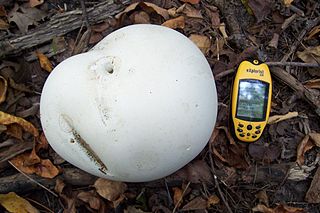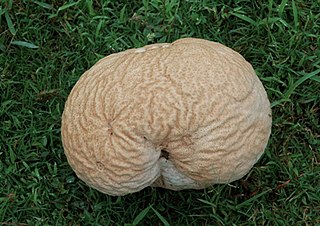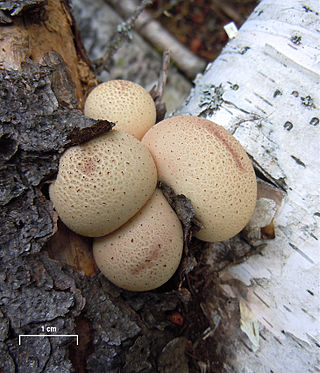
Puffballs are a type of fungus featuring a ball-shaped fruit body that bursts on contact or impact, releasing a cloud of dust-like spores into the surrounding area. Puffballs belong to the division Basidiomycota and encompass several genera, including Calvatia, Calbovista and Lycoperdon. The puffballs were previously treated as a taxonomic group called the Gasteromycetes or Gasteromycetidae, but they are now known to be a polyphyletic assemblage.

Lycoperdon is a genus of puffball mushrooms. The genus has a widespread distribution and contains about 50 species. In general, it contains the smaller species such as the pear-shaped puffball and the gem-studded puffball. It was formerly classified within the now-obsolete order Lycoperdales, as the type genus which, following a restructuring of fungal taxonomy brought about by molecular phylogeny, has been split. Lycoperdon is now placed in the family Agaricaceae of the order Agaricales.

Calvatia gigantea, commonly known in English as the giant puffball, is a puffball mushroom commonly found in meadows, fields, and deciduous forests in late summer and autumn. It is found in temperate areas throughout the world.

Lycoperdon perlatum, popularly known as the common puffball, warted puffball, gem-studded puffball or devil's snuff-box, is a species of puffball fungus in the family Agaricaceae. A widespread species with a cosmopolitan distribution, it is a medium-sized puffball with a round fruit body tapering to a wide stalk, and dimensions of 1.5 to 6 cm wide by 3 to 10 cm tall. It is off-white with a top covered in short spiny bumps or "jewels", which are easily rubbed off to leave a netlike pattern on the surface. When mature it becomes brown, and a hole in the top opens to release spores in a burst when the body is compressed by touch or falling raindrops.

Lycoperdon umbrinum, commonly known as the umber-brown puffball, is a type of Puffball mushroom in the genus Lycoperdon. It is found in China, Europe, Africa, and North America.

Calvatia craniiformis, commonly known as the brain puffball or the skull-shaped puffball, is a species of puffball fungus in the family Agaricaceae. It is found in Asia, Australia, and North America, where it grows on the ground in open woods. Its name, derived from the same Latin root as cranium, alludes to its resemblance to an animal's brain. The skull-shaped fruit body is 8–20 cm (3–8 in) broad by 6–20 cm (2–8 in) tall and white to tan. Initially smooth, the skin (peridium) develops wrinkles and folds as it matures, cracking and flaking with age. The peridium eventually sloughs away, exposing a powdery yellow-brown to greenish-yellow spore mass. The puffball is edible when the gleba is still white and firm, before it matures to become yellow-brown and powdery. Mature specimens have been used in the traditional or folk medicines of China, Japan, and the Ojibwe as a hemostatic or wound dressing agent. Several bioactive compounds have been isolated and identified from the brain puffball.

Apioperdon pyriforme commonly known as the pear-shaped puffball or stump puffball, is a saprobic fungus present throughout much of the world. Emerging in autumn, this puffball is common and abundant on decaying logs of both deciduous and coniferous wood. It is considered a choice edible when still immature and the inner flesh is white. It is often called Lycoperdon pyriforme, but was transferred to Apioperdon in 2017 based on phylogenetic and morphological differences. It is the only species in the genus.

Podaxis pistillaris is a very distinctive relative of the puffballs. It is commonly known as the desert shaggy mane, as it bears a superficial resemblance to the shaggy mane, Coprinus comatus; this species lacks the latter's deliquescing gills, however, and the two are not closely related. It grows to 15 cm high and has a hard, woody stem. The large cap, which protects the blackish spore-bearing tissue, splits, and usually falls away at maturity, allowing the spores to be dispersed by wind. Large numbers may appear after soaking rains. It thrives in deserts and semi-deserts of Australia and other countries, often found on termite mounds in South Africa. In the Hawaiian Islands, it is frequently encountered along roadsides and in disturbed areas on the dry sides of the islands, especially in the Kona area of Hawaii and the Kihei area of Maui.

Bovista is a genus of fungi commonly known as the true puffballs. It was formerly classified within the now-obsolete order Lycoperdales, which, following a restructuring of fungal taxonomy brought about by molecular phylogeny, has been split; the species of Bovista are now placed in the family Agaricaceae of the order Agaricales. Bovista species have a collectively widespread distribution, and are found largely in temperate regions of the world. Various species have historically been used in homeopathic preparations.

Bovista plumbea, commonly known as the tumbling puffball, tumbleball, or paltry puffball, is a small puffball mushroom commonly found in Western Europe and California, white when young and greyish in age. Easily confused with immature Bovista dermoxantha, it is attached to the substrate by a tuft of mycelium.

Handkea utriformis, synonymous with Lycoperdon utriforme, Lycoperdon caelatum or Calvatia utriformis, is a species of the puffball family Lycoperdaceae. A rather large mushroom, it may reach dimensions of up to 25 cm (10 in) broad by 20 cm (8 in) tall. It is commonly known as the mosaic puffball, a reference to the polygonal-shaped segments the outer surface of the fruiting body develops as it matures. Widespread in northern temperate zones, it is found frequently on pastures and sandy heaths, and is edible when young. H. utriformis has antibiotic activity against a number of bacteria, and can bioaccumulate the trace metals copper and zinc to relatively high concentrations.

Calvatia sculpta, commonly known as the sculpted puffball, the sculptured puffball, the pyramid puffball, or Sierran puffball, is a species of puffball fungus in the family Agaricaceae. Attaining dimensions of up to 8 to 15 cm tall by 8 to 10 cm wide, the pear- or egg-shaped puffball is readily recognizable because of the large pyramidal or polygonal warts covering its surface. It is edible when young, before the spores inside the fruit body disintegrate into a brownish powder. The spores are roughly spherical, and have wart-like projections on their surfaces.

Calvatia cyathiformis, or purple-spored puffball, is a large edible saprobic species of Calvatia. This terrestrial puffball has purplish or purple-brown spores, which distinguish it from other large Agaricales. It is found in North America and Australia, mostly in prairie or grassland environments.

Lycoperdon echinatum, commonly known as the spiny puffball or the spring puffball, is a type of puffball mushroom in the family Agaricaceae. The saprobic species has been found in Africa, Europe, Central America, and North America, where it grows on soil in deciduous woods, glades, and pastures. It has been proposed that North American specimens be considered a separate species, Lycoperdon americanum, but this suggestion has not been followed by most authors. Molecular analysis indicates that L. echinatum is closely related to the puffball genus Handkea.
Lycoperdon radicatum is a species of puffball mushroom, also called rooting puffball, in the family Agaricaceae. It was described in 1848 by French botanists Michel Charles Durieu de Maisonneuve and Camille Montagne in Algeria. Due to its Bovista-like capillitium it was previously placed in the genus Bovistella. It is nonpoisonous. It is easily recognised by its 4-8 cm rigid, white-gray pseudoroot.

Lycoperdon curtisii is a type of puffball mushroom in the genus Lycoperdon. It was first described scientifically in 1859 by Miles Joseph Berkeley. Vascellum curtisii, published by Hanns Kreisel in 1963, is a synonym. Its fruit bodies (puffballs) have been recorded growing in fairy rings. It is nonpoisonous.

Lycoperdon molle, commonly known as the smooth puffball or the soft puffball, is a type of puffball mushroom in the genus Lycoperdon. It was first described scientifically in 1799 by Dutch mycologist Christiaan Hendrik Persoon. The puffball is edible when the internal flesh is still white.

Lycoperdon marginatum, commonly known as the peeling puffball, is a type of puffball mushroom in the genus Lycoperdon. A common species, it is found in Europe and North America, where it grows on the ground. It is characterized by the way that the spiny outer layer peels off in sheets.

Calostoma cinnabarinum, commonly known as the stalked puffball-in-aspic,gelatinous stalked-puffball, or red slimy-stalked puffball, is a species of gasteroid fungus in the family Sclerodermataceae, and is the type species of the genus Calostoma. The fruit body has a distinctive color and overall appearance, featuring a layer of yellowish jelly surrounding a bright red, spherical head approximately 2 centimeters (0.8 in) in diameter atop a red or yellowish brown spongy stipe 1.5 to 4 cm tall. The innermost layer of the head is the gleba, containing clear or slightly yellowish elliptical spores, measuring 14–20 micrometers (µm) long by 6–9 µm across. The spore surface features a pattern of small pits, producing a net-like appearance. A widely distributed species, it grows naturally in eastern North America, Central America, northeastern South America, and East Asia. C. cinnabarinum grows on the ground in deciduous forests, where it forms mycorrhizal associations with oaks.

Bovista pila, commonly known as the tumbling puffball, is a species of puffball fungus in the family Agaricaceae. A temperate species, it is widely distributed in North America, where it grows on the ground on road sides, in pastures, grassy areas, and open woods. There are few well-documented occurrences of B. pila outside North America. B. pila closely resembles the European B. nigrescens, from which it can be reliably distinguished only by microscopic characteristics.

















